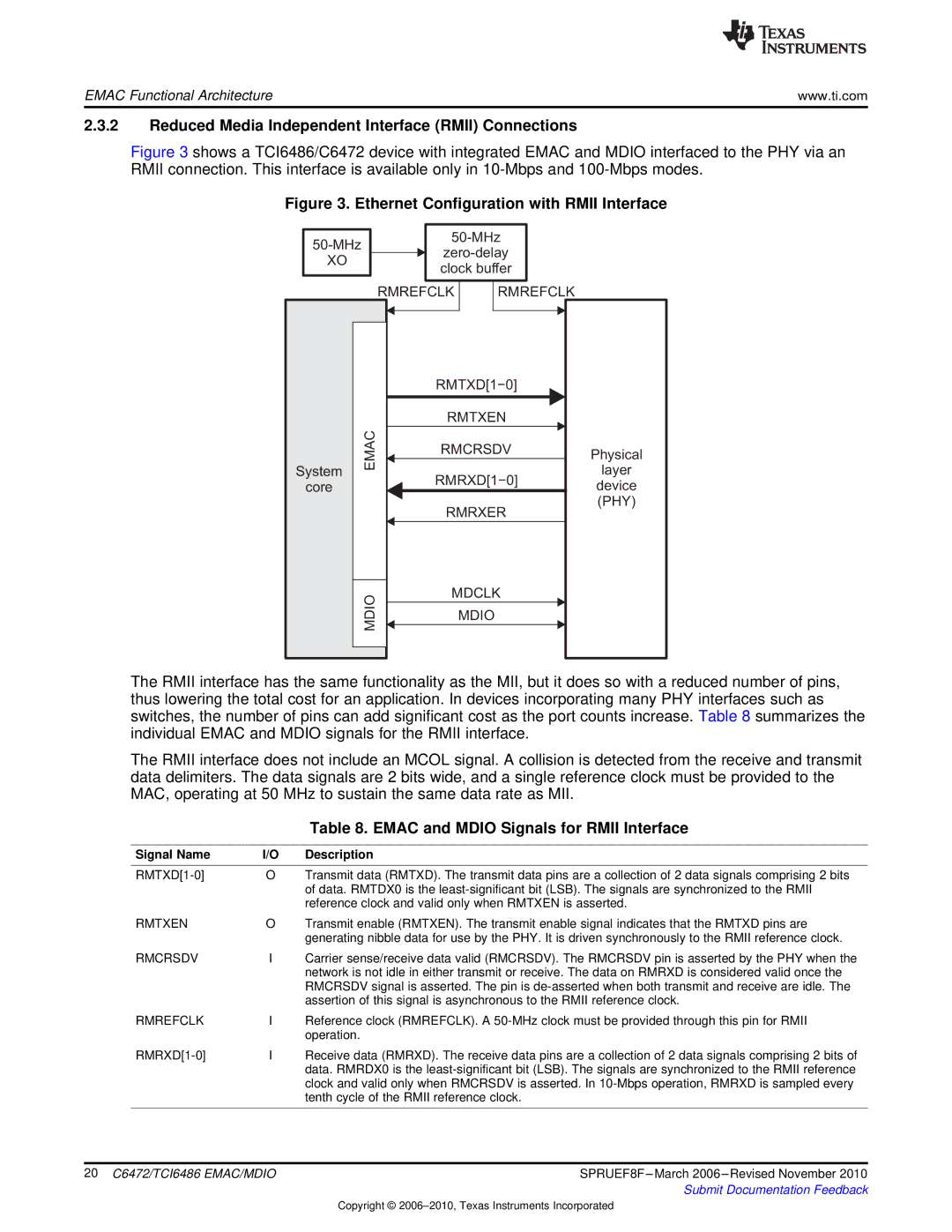
EMAC Functional Architecture | www.ti.com |
2.3.2Reduced Media Independent Interface (RMII) Connections
Figure 3 shows a TCI6486/C6472 device with integrated EMAC and MDIO interfaced to the PHY via an RMII connection. This interface is available only in 10-Mbps and 100-Mbps modes.
Figure 3. Ethernet Configuration with RMII Interface
XO
|
| RMREFCLK | RMREFCLK |
|
|
| RMTXD[1−0] |
| |
| EMAC | RMTXEN |
| |
| RMCRSDV | Physical | ||
|
| |||
|
|
|
| |
System |
| RMRXD[1−0] | layer | |
core |
| device | ||
|
|
| ||
|
| RMRXER | (PHY) | |
|
|
| ||
| MDIO | MDCLK |
| |
|
| MDIO |
| |
|
|
|
| |
The RMII interface has the same functionality as the MII, but it does so with a reduced number of pins, thus lowering the total cost for an application. In devices incorporating many PHY interfaces such as switches, the number of pins can add significant cost as the port counts increase. Table 8 summarizes the individual EMAC and MDIO signals for the RMII interface.
The RMII interface does not include an MCOL signal. A collision is detected from the receive and transmit data delimiters. The data signals are 2 bits wide, and a single reference clock must be provided to the MAC, operating at 50 MHz to sustain the same data rate as MII.
|
| Table 8. EMAC and MDIO Signals for RMII Interface |
|
|
|
Signal Name | I/O | Description |
|
|
|
O | Transmit data (RMTXD). The transmit data pins are a collection of 2 data signals comprising 2 bits | |
|
| of data. RMTDX0 is the |
|
| reference clock and valid only when RMTXEN is asserted. |
RMTXEN | O | Transmit enable (RMTXEN). The transmit enable signal indicates that the RMTXD pins are |
|
| generating nibble data for use by the PHY. It is driven synchronously to the RMII reference clock. |
RMCRSDV | I | Carrier sense/receive data valid (RMCRSDV). The RMCRSDV pin is asserted by the PHY when the |
|
| network is not idle in either transmit or receive. The data on RMRXD is considered valid once the |
|
| RMCRSDV signal is asserted. The pin is |
|
| assertion of this signal is asynchronous to the RMII reference clock. |
RMREFCLK | I | Reference clock (RMREFCLK). A |
|
| operation. |
I | Receive data (RMRXD). The receive data pins are a collection of 2 data signals comprising 2 bits of | |
|
| data. RMRDX0 is the |
|
| clock and valid only when RMCRSDV is asserted. In |
|
| tenth cycle of the RMII reference clock. |
|
|
|
20 C6472/TCI6486 EMAC/MDIO | SPRUEF8F |
Submit Documentation Feedback
Copyright ©
